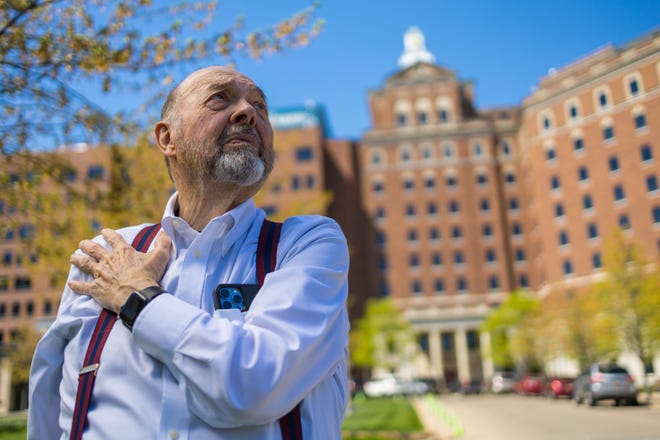

While walking through the bike trails near Cincinnati's Lunken Airport one February day, William Fryer's legs started to feel like rubber.
He had been feeling ill all week but chose to take a walk after feeling better that day. His leg discomfort didn't alarm him at first.
"I did this as a kid, I would run until my legs gave out and I would go down," the 83-year-old said with a laugh, noting that he always landed somewhere soft like a grass field before popping right back up.
But as he continued, Fryer eventually realized something was wrong. Fearing he wouldn't be able to finish the walk back to his home, he veered behind some trees away from the path where he said if he were to fall he may be seen by some people out and about. He made it about 30 more yards before collapsing.
"I blacked out because I don't remember going down and hitting ground," he recalled.
Can smartwatches literally save lives?Some users say yes
USA TODAY:Your smartwatch or phone's lifesaving features only work if you know how to turn them on
He regained consciousness within seconds and noticed an off-duty police officer and her husband who saw him nearby had quickly come over to help. But before they got there, Fryer was already receiving assistance. His Apple Watch had called emergency medical services and he awoke to an operator on the line.
"I rolled over on my back and I could hear the phone asking if it was OK to call for emergency services," Fryer said.
The officer spoke with EMS as Fryer, who had just awakened, listened. EMS responders weren't able to pinpoint why Fryer had fallen. They sent an ambulance and he was taken to Christ Hospital.
Troubling discovery
Emergency room doctors at Christ also had trouble identifying what caused Fryer, who showed up to the hospital in a spirited mood and not feeling any additional symptoms, to collapse.
A chest computed tomography scan however, showed he had developed a large pulmonary embolism. A pulmonary embolism, or PE, is a blood clot that causes a blockage in pulmonary arteries, the blood vessels that flow blood to the lungs. The blockage forces the heart to work harder and can lead to cardiac damage.
Large PEs can come with a 20% risk of death within 30 days. Fryer's PE was substantial enough that Christ doctors became concerned and called Dr. Scott Tatum, a vascular and interventional radiologist, to weigh in.

"I immediately thought this was probably something that cannot wait," Tatum said. "This is probably something I need to go see right now."
Tatum went into the hospital and began asking Fryer some questions. Fryer revealed that he was feeling fine and since the fall hasn't had anything abnormal happen. His demeanor was calm and he was still showing no signs of what caused the fall.
When Tatum pressed a little further to try to get a sense of how Fryer was doing in relation to his baseline heart rate, he was shocked at what Fryer showed him next. Fryer pulled out his phone and had detailed records of his heart rate from the last few months initiated from his Apple Watch that he could show the doctor. Those records helped Tatum in determining what action should be taken. The doctor was able to see how serious the PE was from how abnormal his heart rate and blood pressure were.
"I basically said I'm worried you will do very poorly unless we take action," Tatum said.
Fryer stayed overnight at the hospital as Tatum's team pulled out the blood clot from his lung. The procedure went so smoothly and Fryer responded so well, he was discharged the next day.
"The automation of his watch allowed for us to identify the problem very quickly and treat the problem very quickly," Tatum said. "A lot of patients that have pulmonary embolism usually stay in the hospital for like two or three days."

Growing trend of smartwatches as a resource
Fryer's story isn't unique. There's been a growing trend of smartwatch use for peace of mind for elder individuals and for people with preexisting conditions that could need assistance at the drop of a hat.
While many false alarms occur at the gym or during a normal work, shift, the technology has been used to provide assistance to people in critical need. Watches like the Apple Watch, FitBit, Google's Pixel Watch and Samsung's Galaxy Watch have settings where individuals can customize their response preferences.
In one case in Tampa, Florida, a teenager experiencing a skyrocketed resting heart rate received a notification of an abnormality that led to an ambulance response and a kidney failure diagnosis.
In Utah, a man had a sluggish heart rate well below his normal baseline, and a FitBit kick-started a trip to the hospital where he learned he had a 50/50 chance to survive.
Another woman, a mother of a 9-month-old in Florida, was hit by a drunk driver and an automatic response from her watch expedited an emergency call, as she couldn't find her phone in the wreck, according to CNET.
Fryer set his watch so that it notifies his daughter any time something abnormal happens. Since Fryer lives alone, that gives them both peace of mind, he said.
"That part is important to family members," he said. "Wherever I go down, it's going to call for help."
Tatum said while each injury and medical situation are different, the smart watch technology presents a valuable resource that will likely grow in use.
"Can I broadly say that for every patient in every scenario, that this will be a lifesaver? No, but for this particular man, this was a life-saving piece of equipment that he had on," he said.
Source link





